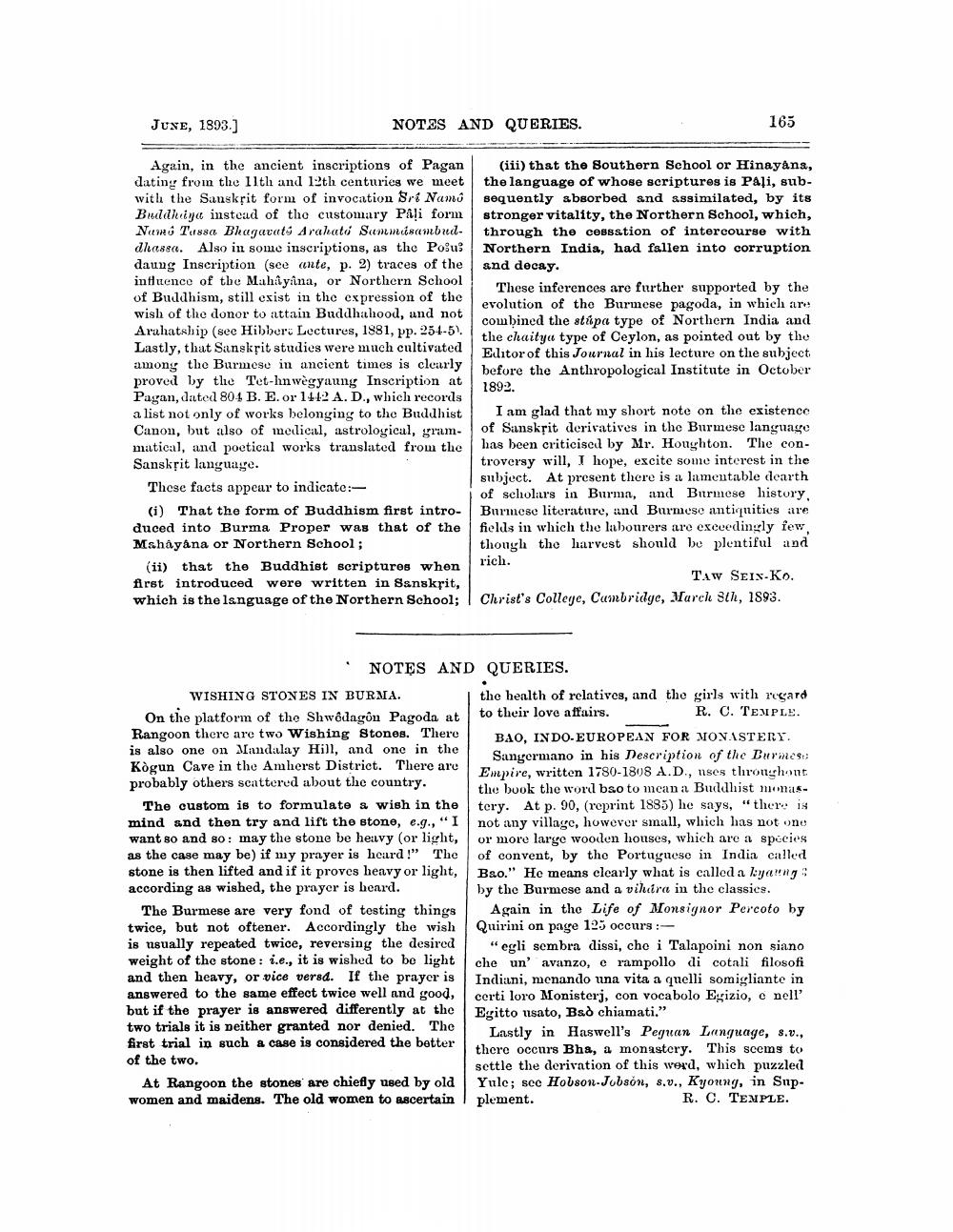________________
JUXE, 1893.)
NOTES AND QUERIES.
165
Again, in the ancient inscriptions of Pagan (iii) that the Southern School or Hinayana, dating from the Ilth and 12th centuries we meet the language of whose scriptures is Pali, subwith the Sanskrit form of invocation Sri Namûsequently absorbed and assimilated, by its Buddhiya instead of the customary Påļi form stronger vitality, the Northern School, which, Nawu Tursa Bhagavaty Arahati Sanmisambud. through the cessation of intercourse with dhassa. Also in some inscriptions, as tho Pošus Northern India, had fallen into corruption daung Inscription (see ante, p. 2) traces of the and decay. influence of the Mahiyaina, or Northern School
These inferences are further supported by the of Buddhism, still exist in the expression of the
evolution of the Burmese pagoda, in which ar wish of the donor to attain Buddhahood, and not
combined the stúpa type of Northern India and Arahatship (see Hibbero Lectures, 1881, pp. 251-5).
the chaitya type of Ceylon, as pointed out by the Lastly, that Sanskrit studies were much cultivated
Eclitor of this Journal in his lecture on the subject among the Burmese in ancient times is clearly
before the Anthropological Institute in October proved by the Tet-hn wègyaung Inscription at Pagan, dated 804 B. E. or 142 A.D., which records a list not only of works belonging to the Buddhist I am glad that my short note on the existence Canon, but also of medical, astrological, gram- of Sanskrit derivatives in the Burmese language matical, and poetical works translated from the
has been criticised by Mr. Houghton. The conSanskpit language.
troversy will, I hope, excite some interest in the
subject. At present there is a lamentable dearth These facts appear to indicate:
of scholars in Burma, and Burmese history, (i) That the form of Buddhism first intro- Burmese literature, and Burmese antiquities are duced into Burma Proper was that of the fields in which the labourers are exceedingly few Mshayana or Northern School;
though the harvest should be plentiful and (ii) that the Buddhist scriptures when
rich.
Taw SEIX-Ko. first introduced were written in Sanskrit, which is the language of the Northern School; | Christ's College, Cambridge, March 3th, 1893.
1892.
. NOTES AND QUERIES. WISHING STONES IN BURMA.
the health of relatives, and the girls with recard On the platform of the Shwedagon Pagoda at
to their love affairs.
R. C. TEMPLE. Rangoon there are two Wishing Stones. Thero
BAO, IN DOEUROPEAN FOR MONASTERY, is also one on Mandalay Hill, and one in the
Sangermano in his Description of the Burmese: Kògun Cave in the Amherst District. There are
Empire, written 1780-1808 A.D., nses throughout probably others scattered about the country.
the book the word bso to mean a Buddhist emasThe custom is to formulate a wish in the tery. At p. 90, (reprint 1885) he says, "there is mind and then try and lift the stone, e.g., "I not any village, however small, which has not one want so and so: may the stone be heavy (or light, or more large wooden houses, which are a species as the case may be) if my prayer is heard!" The of convent, by the Portuguese in India called stone is then lifted and if it proves heavy or light, Bao." He means clearly what is called a kyang according as wished, the prayer is heard.
by the Burmese and a vihera in the classics. The Burmese are very fond of testing things Again in the Life of Monsignor Percoto by twice, but not oftener. Accordingly the wish Quirini on page 125 occurs :is nsually repeated twice, reversing the desired "egli sembra dissi, cho i Talapoini non siano weight of the stone: i.e., it is wished to be light che un' avanzo. e rampollo di cotali filo and then heavy, or vice versa. If the prayer is Indiani, menando una vita a quelli somigliante in answered to the same effect twice well and good, certi loro Monisterj, con vocabolo Egizio, o nell' but if the prayer is answered differently at the
Egitto usato, Bsd chiamati." two trials it is neither granted nor denied. The
Lastly in Haswell's Peguan Language, s.v., first trial in such a case is considered the better
there occurs Bha, a monastery. This seems to of the two.
settle the derivation of this word, which puzzled At Rangoon the stones are chiefly used by ola Yulc; scc Hobson-Jobson, s.v., Kyoung, in Supwomen and maidens. The old women to ascertain plement.
R. C. TEMPLE.
.




